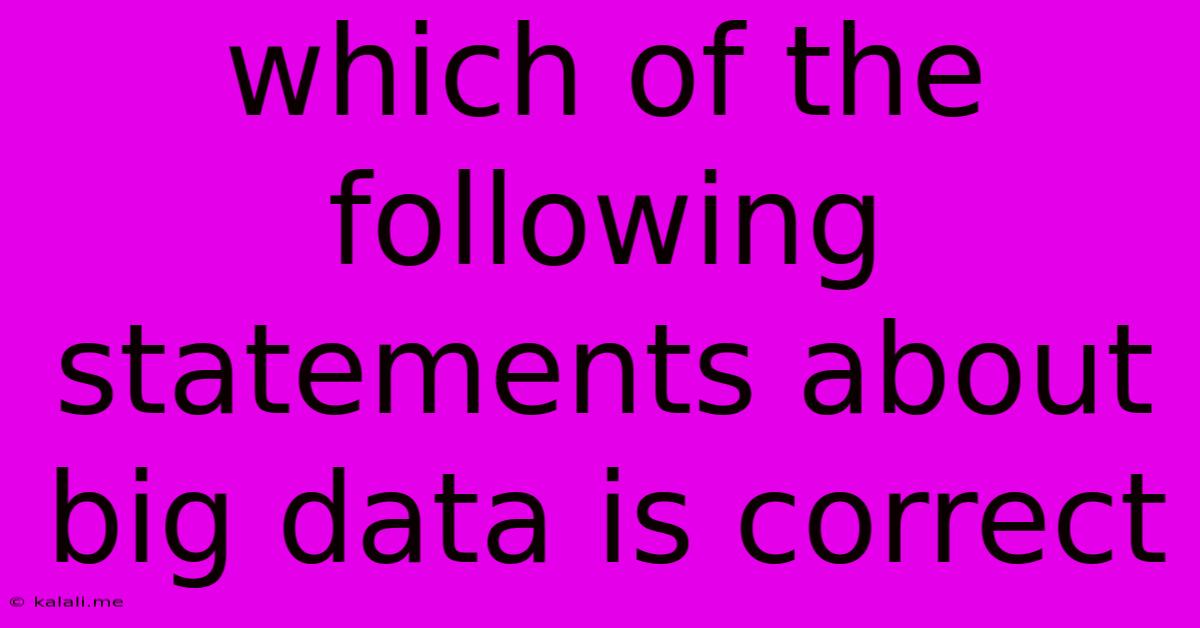Which Of The Following Statements About Big Data Is Correct
Kalali
Jun 14, 2025 · 3 min read

Table of Contents
Which of the following statements about Big Data is correct? Debunking Common Myths and Unveiling the Truth
Big data. The term itself conjures images of massive datasets, complex algorithms, and groundbreaking insights. But what exactly is big data, and what statements about it actually hold true? This article will dissect common claims surrounding big data, separating fact from fiction and helping you understand this powerful technological force. Understanding big data's characteristics is crucial for businesses looking to leverage its potential for improved decision-making and competitive advantage.
Defining Big Data: More Than Just Size
Before we delve into the correctness of various statements, it's important to establish a clear definition. Big data isn't simply about the volume of data; it's characterized by the five Vs:
- Volume: The sheer scale of data being generated.
- Velocity: The speed at which data is generated and processed.
- Variety: The diverse formats of data (structured, semi-structured, unstructured).
- Veracity: The trustworthiness and accuracy of the data.
- Value: The potential insights and benefits that can be extracted from the data.
Now, let's address some common statements about big data and determine their accuracy:
Statement 1: "Big data is only useful for large corporations with massive budgets." INCORRECT
While large corporations often benefit most from big data analytics due to their scale, the reality is that big data solutions are becoming increasingly accessible to smaller businesses and organizations. Cloud-based solutions and affordable analytics tools have democratized access, allowing even startups to leverage the power of big data for market research, customer segmentation, and improved operational efficiency.
Statement 2: "All big data needs to be stored in a single, centralized data warehouse." INCORRECT
This is a common misconception. The architecture of big data solutions is often distributed and decentralized. Data may reside in multiple locations, leveraging various storage technologies depending on the type and volume of data. This distributed approach ensures scalability and resilience, avoiding single points of failure. Techniques like Hadoop and NoSQL databases are commonly used to manage this distributed data.
Statement 3: "Big data analytics automatically provides actionable insights without human intervention." INCORRECT
While advanced algorithms can automate parts of the process, big data analytics still requires significant human expertise. Data scientists and analysts play a critical role in defining the problem, selecting appropriate algorithms, interpreting the results, and translating those findings into actionable strategies. The human element remains indispensable for contextual understanding and effective decision-making.
Statement 4: "Big data guarantees 100% accurate predictions." INCORRECT
Big data analytics can significantly improve the accuracy of predictions and forecasts, but it doesn't guarantee perfect accuracy. The quality of the data, the choice of algorithms, and the inherent randomness of many phenomena all contribute to the uncertainty of predictions. Big data provides a more informed basis for decision-making, but it's not a crystal ball.
Statement 5: "Big data is solely about collecting and storing as much data as possible." INCORRECT
While collecting large volumes of data is a component of big data, the ultimate goal is to extract value from that data. The focus is on deriving meaningful insights, improving processes, enhancing decision-making, and achieving specific business objectives. The emphasis should always be on data quality, relevance, and the ability to translate data into tangible results. This includes aspects like data governance and data security.
Conclusion:
Big data is a powerful tool with the potential to revolutionize industries and organizations of all sizes. However, a clear understanding of its characteristics and limitations is essential for its effective utilization. By dispelling common misconceptions and focusing on the value-driven aspects of big data, businesses can unlock its transformative potential and gain a significant competitive advantage.
Latest Posts
Latest Posts
-
Which Of The Following Is An Example Of A Decomposer
Jun 14, 2025
-
Second Most Abundant Element On Earth
Jun 14, 2025
-
In Which Stage Of Meiosis Crossing Over Takes Place
Jun 14, 2025
-
Which Is Not A Function Of The Cytoskeleton
Jun 14, 2025
-
One Astronomical Unit Is Equal To
Jun 14, 2025
Related Post
Thank you for visiting our website which covers about Which Of The Following Statements About Big Data Is Correct . We hope the information provided has been useful to you. Feel free to contact us if you have any questions or need further assistance. See you next time and don't miss to bookmark.